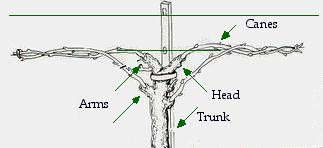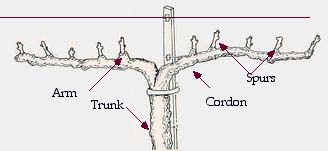Pruning 101
Pruning: The act of trimming or removing what is superfluous. The main purpose of pruning grape vines is to regulate crop load and vine balance. Vines can self regulate shoot numbers based on their capacity however humans like to control and manipulate the growth of vines for qualitative reasons. Pruning is performed during the winter months when the vine is dormant. Sometimes pruning is performed at the start of spring when the buds are swelling to shock the vines and delay bud burst. This is common practice in areas/sites that are prone to spring frosts in an effort to reduce the risk of crop loss.
Two main types of pruning:
Cane
Usually 1-4 canes retained depending on plant spacing, vine capacity and target yield. A replacement spur on each side of the head gives rise to next years fruiting cane and replacement spur. Old cordons and unwanted canes are removed manually from the trellis system.
Cane pruning is more commonly practiced in cool climate viticulture. It will produce higher numbers of clusters/shoot and potentially larger clusters than spur pruning. Therefore in years of poor set there will be more fruit than a spur pruned vine.
Cool cloudy springs inflorescence primordial development* particularly at proximal buds. This means the buds closer to the vines have less potential clusters/shoot or smaller potential clusters than those further up the cane. Cane pruning is more expensive, requires more skill and is less mechanized.

Spur
Spurs are canes cut back to 2 buds along a permanent cordon. Spurs are spaced approximately 3-4 inch apart but more buds are retained per spur or spurs density is changed depending on vine capacity and target yield.
Spur pruning is more commonly practiced in warmer climates where vines have better proximal bud inflorescence primordial development. This system is more easily mechanized, costs less and requires less skill.

There are many variations on these two pruning techniques to different training/trellis systems.
* Inflorescence primordia are miniscule undeveloped clusters inside either the primary or the secondary buds. The term for the singular is primordium. Their size is related to the number of flowers with potential to transform into a berry and, therefore, to final cluster size. Inflorescence primordial development is temperature and light dependent thus buds further up the canes develop later in spring when light and heat is more abundant.
Comments
Commenting has been turned off.Recent Posts
-
October 12, 2018
-
June 7, 2018
-
October 30, 2017
-
October 23, 2017
-
September 13, 2017
-
April 17, 2017
-
July 21, 2016
-
June 2, 2016
-
May 25, 2016
-
May 18, 2016
Blog Categories
Blog Archives
Our Writers
- Leanne Bellncula (2)
- Shelli Brinson Fowler (1)
- Tom Caruso (2)
- Ryan Collins (20)
- Bill Hatcher (10)
- Deb Hatcher (2)
- REX HILL (59)
- Kelly Irelan (1)
- Carrie Kalscheuer (3)
- Jonathan Lampe (3)
- Karina Lopez (1)
- Meredith McGough (1)
- Katie McLennan (2)
- Charlotte Mischel (2)
- Karen Peterson (2)
- Olivier Prost (2)
- Tom Reed (1)
- Emily Sadler (1)
- Sam Tannahill (2)
- Mike Willison (4)

